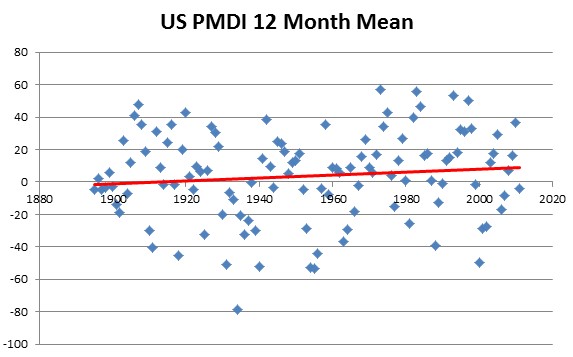It appears that Hansen is completely uninterested in any climate data which he hasn’t tampered with.
His claims of permanent drought are not consistent with the US drought record, which shows a decrease in drought and increase in wetness since records started in 1895.
Contiguous U.S., Palmer Modified Drought Index (PMDI), January-December 1895-2011



Hansen’s mind is of the beautiful variety and unconstrained by reality.
It is not enough to compute the slope and the offset. You should also calculate the error in the slope and in the offset from the scattering of the data. There are standard least squares formulas for doing this. In this case, the scatter is so large, I’d be surprised if the error was not similarly large. When the error is taken into account, you’d probably see that “no-change” is well within the error bar of the final result. Just a guess, mind you. I suspect the same to be the case with other results in climatology.
There is no “error” in objective measurement (except slight such from the actual).
What you are referring to is deviation.
The trend of the data is still very evident.
The standard deviation in this case is the measure of error. Every measurement in physics always has some error associated with it. In this case what you want to measure is the slope of a linear fit to the data that is otherwise strongly scattered. The scatter of the data determines the error in your estimate of the slope. How? The standard deviation in the slope is the error. Error estimates is something that is notoriously lacking in all these discussions about climate–from all sides. For starters, we should look at how good is the hypothesis that the data is well described by a linear dependence to begin with. This is another source of the problem. The variation is not really linear at all. We should look at cycles instead. As it happens, people like Scafetta have done just this and found climate cycles perfectly matching with lunar/solar tidal interactions, as well as with the cyclic distortions of the Earth’s orbit by Jupiter and Saturn. The Earth climate system turns out to be highly sensitive to such interactions. Well, we know this, because we can observe ocean tides every day, as they react to the moon. A more careful analysis shows that the respective positions of the moon and the sun matter. So, the tides react to the sun as well. And we have known for centuries now that Jupiter does affect the Earth’s orbit in a way that is both computable (analytically) and measurable. The surprise is that this affects the Earth’s climate. But the cycles are there, clearly readable.